Summer grab-bag, part two: Vinegar Syndrome
Vinegar Syndrome’s release schedule this year has been a mixed-bag. I’m not sure whether I’ll renew my subscription next year … if I can find the energy I’ll have to do a cost breakdown to compare the subscription price to the alternative of just buying individual titles. There is some benefit, though, as I automatically receive new releases that I might have had no interest in but which turn out to be worthwhile after all.
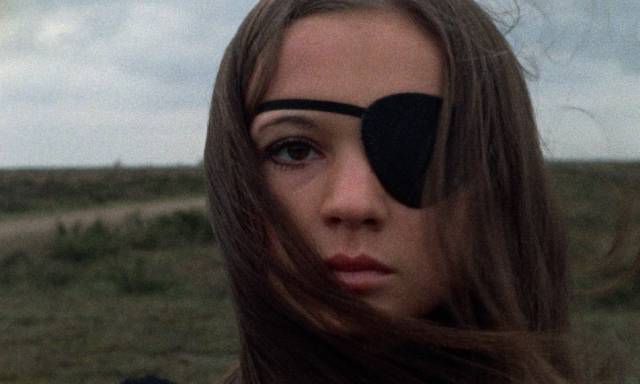
Thriller: A Cruel Picture (Bo Arne Vibenius, 1973)
Thriller: A Cruel Picture (1973) is not what you’d expect from someone who had worked with Ingmar Bergman on Persona (1966) and Hour of the Wolf (1968). Bo Arne Vibenius’ movie is as blunt as its title; it takes exploitation elements and uses them in uncomfortable, unsettling ways. The thriller part involves a rape-revenge narrative, but more important is the cruelty. Made with a cool, unflinching detachment, it strips out the kind of visceral pleasures typical of the genre and leaves the viewer numb and battered. It’s the kind of movie you get when a filmmaker deliberately sets out to make something commercial only to have their creative instincts subvert the material.
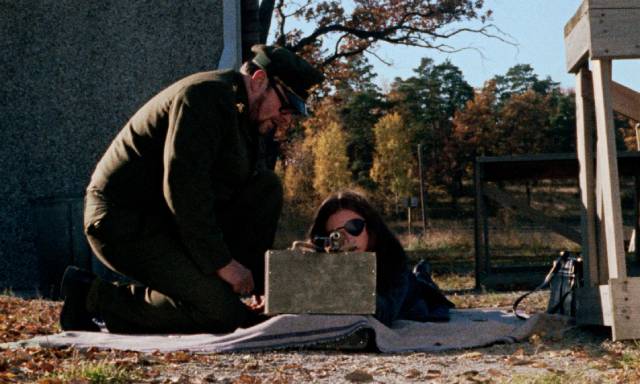
Madeleine (Christina Lindberg) is a deaf-mute girl who lives with her parents on a farm. Going to town one day, she misses the bus and accepts a ride from Tony (Heinz Hopf), a seemingly friendly man who kidnaps her, gets her hooked on heroin, and starts selling her to his customers. When she rebels at one point, he cuts out one of her eyes; the black eye patch she wears adds a fetishistic appeal. Vibenius uses graphic hardcore imagery to depict her sexual slavery, imagery devoid of any erotic charge as it reduces Madeleine to a mere mechanical vessel for sleazy men to make use of.
Dependent on Tony for her daily drug fix, Christina seems to submit to this bleak new life; eventually, she has a certain degree of freedom, with regular time off and money to spend. When she learns that Tony sent a letter to her parents, purportedly from her, saying how much she hated them and the life she had been forced to live on the farm, and that the aging couple had committed suicide, she embarks on a methodical plan – using her spare time and money, she finds someone to train her in fighting skills, to teach her to drive, and to train her with various weapons. And when she’s ready, she sets out to kill the men who have paid to abuse her, working her way up to Tony himself.
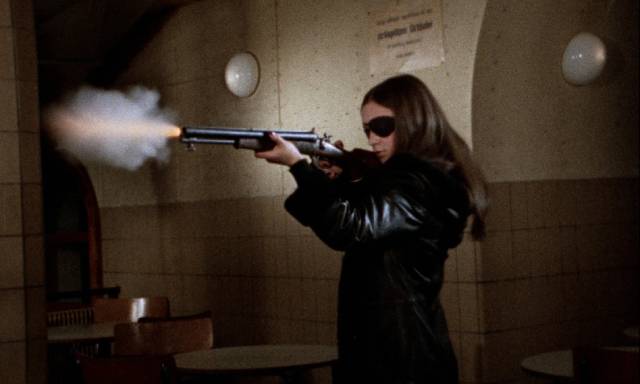
She goes about all this with a kind of passive determination; there’s no sense of triumph or release. Her revenge is almost as impersonal as Tony’s methods for enslaving vulnerable young women. Vibenius’ depicts all this unpleasantness and cruelty with visual precision; the camerawork and editing are unflinching, preventing the viewer from avoiding the painful implications of everything being shown. In effect, the film is an anti-thriller, withholding the generic entertainment it seems to promise. It leaves one feeling bludgeoned and indicted for expecting this to be in any way fun.
Vinegar Syndrome’s dual-format edition presents two versions of the movie on both Blu-ray and 4K UHD – the original Swedish cut and the American-International cut, eighteen minutes shorter and shorn of the more explicit imagery, with some additional material shot by Vibenius for a “softer” version. I haven’t yet watched the AIP version, retitled They Call Her One-Eye, so can’t comment on the differences. The Thriller disk includes a 43-minute retrospective documentary in which interviews with participants are framed by narration written by Vibenius (who refers to himself in the third person throughout). There are other interviews and featurettes on the One-Eye disk which I haven’t watched yet.
*
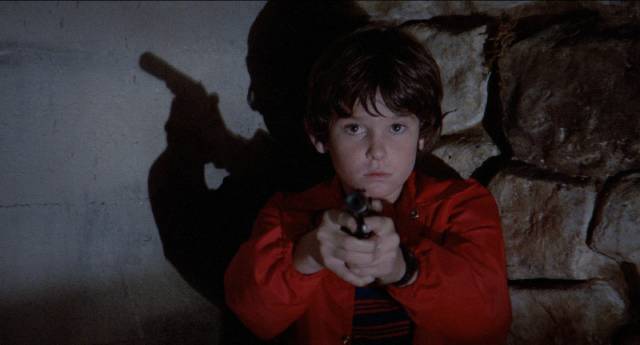
Cloak & Dagger (Richard Franklin, 1984)
You couldn’t get much further from Thriller than Richard Franklin’s Cloak & Dagger (1984), a movie which plays with thriller tropes in the context of a kids’ movie. With his mother having recently died and his father emotionally distant, Davey (Henry Thomas) retreats into fantasy, accompanied by his imaginary friend Jack Flack (Dabney Coleman), a secret agent from a video game. When Davey witnesses an FBI agent being murdered, and the dying man gives him a video game cartridge, he’s sucked into a real-life espionage story in which his only help comes from his friend Kim (Christina Nigra) and Morris (William Forsythe), who owns a videogame and electronics store.
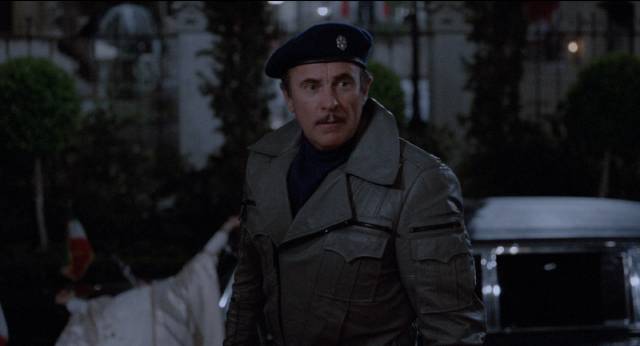
Since adults can’t be trusted – even an elderly tourist couple may pose a threat – Davey has to figure out how to save himself while deciphering the information concealed in the video game. For a kids’ movie (made just two years after Thomas starred in E.T.), Cloak & Dagger has a surprisingly high body count as Davey takes on an enemy spy ring with the help of Jack Flack’s advice. Along with other ’80s movies like John Badham’s WarGames (1983), Cloak & Dagger nodded towards adolescent tech savvy in high-stakes thrillers which in retrospect seem more rooted in ’70s paranoia than cartoonish variations like Robert Rodriguez’s Spy Kids franchise (2001-11). Not surprisingly, all the danger and violence are put in service of reconciling Davey with his emotionally distant father (Dabney Coleman, naturally).
The dual-format Blu-ray/4K UHD set includes a commentary with writer Tom Holland, a new making-of documentary, some additional interviews and a featurette on the Atari arcade Cloak & Dagger game.
*
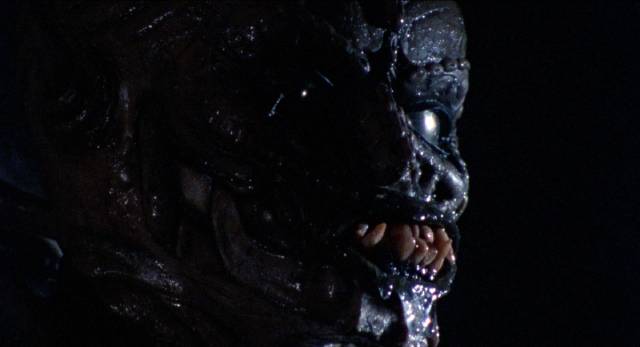
Scared to Death (William Malone, 1980)
My favourite William Malone feature remains his 1999 remake of William Castle’s House on Haunted Hill, which is creepy and deftly attuned to the original movie’s acidic depiction of a bitter marriage. But that came two decades after Malone’s career began with a pair of very low-budget sci-fi/horror movies perhaps too obviously indebted to Ridley Scott’s Alien (1979). The second, Creature (1985), was released by VS last year; now here’s Malone’s debut, Scared to Death (1980), a scrappy mix of alien and slasher tropes, shot on a minuscule budget in 16mm. Like the Creature release, this includes two alternate cuts – the theatrical version restored in 4K from the original 16mm negative, and Malone’s director’s cut (completed last year), which is slightly shorter (I haven’t watched both, so can’t speak to the differences between them).
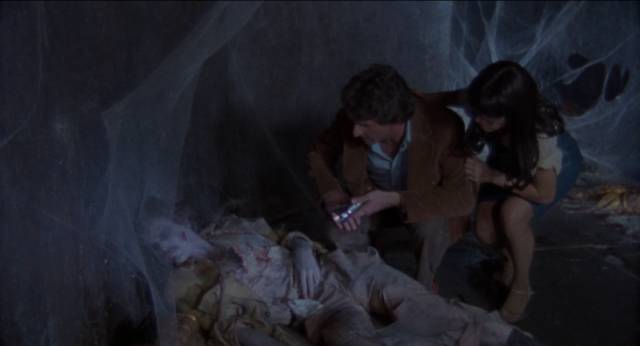
While there are cliches and technical weaknesses, and some less-than-stellar performances, Malone and his team handle the monster effects quite well, obviously putting the majority of their resources into what matters most from a commercial stand-point. The narrative follows retired cop Ted Lonergan (John Stinson) who’s called in by his old partner (David Moses) to help with a troubling case in which a serial killer is preying on women in Los Angeles. It soon becomes apparent that the killer isn’t human – in fact, it’s a Syngenor (synthetic genetic organism), a corporate creation (whoops, another advanced weapons project gone wrong) which is mutating, and possibly getting ready to reproduce.
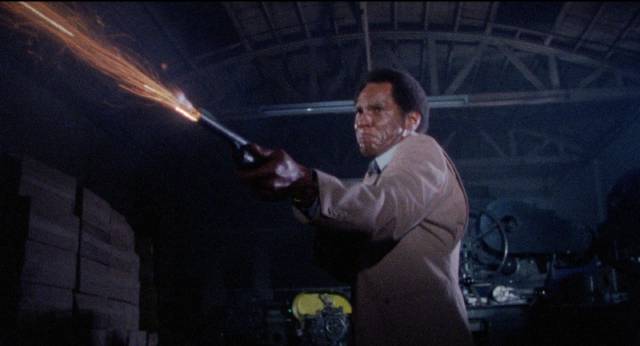
Ted teams up with research scientist Jennifer Stanton (Diana Davidson), who knows more about the creature than she initially lets on. The pair don’t have a lot of time for romance as they try to put an end to the bloody rampage.
The grainy 16mm photography gives the movie a gritty look which serves the exploitation elements well while allowing Malone and the effects crew to conceal any deficiencies there might be in the make-up and animatronics. Like Creature, Scared to Death makes no effort to conceal its borrowings from bigger-budgeted movies, but the filmmakers’ enthusiasm for what they’re doing makes those borrowings forgivable.
The disk includes a commentary, a making-of documentary, a featurette on locations and even a music video.
*
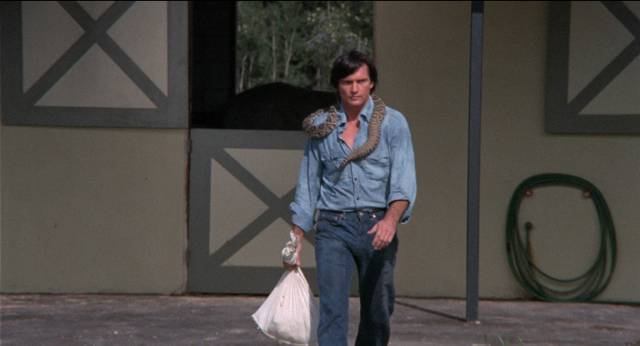
Stanley (William Grefé, 1972)
/ Horror High (Larry Stouffer, 1973)
William Grefé followed his sordid Rita Hayworth movie The Naked Zoo (1970) with the first of his two accomplished nature’s revenge movies. There are many parallels between Stanley (1972) and Mako: The Jaws of Death (1976). Both movies feature an isolated, misanthropic hero who relates more to deadly animals than people; both justify the allegiance of those men to the animals by surrounding them with vicious, venal characters who brutalize their beloved critters – snakes in the case of Stanley, sharks in Mako. In both movies, the hero aids scientists in their research only to be betrayed – as they are betrayed by friends who work in night clubs to whom they supply animals which they mistakenly (and naively) believe will be treated well. And in both, the hero uses his almost supernatural bond with his animal friends to wreak revenge on those who’ve abused his trust.
More disturbingly, in both movies there is some very real animal violence which rather undercuts the pro-nature message.
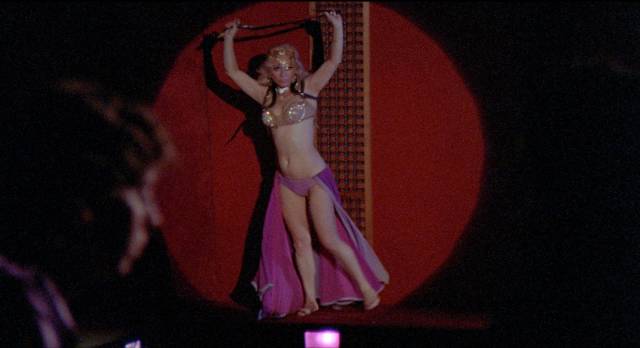
In Stanley, the title character is a particular snake which spends much of its time draped around the neck of First Nations Vietnam vet Tim Ochopee (Chris Robinson) who lives out in the swamps of Florida, surrounded by snakes which he nurtures (somewhat creepily, he even has wedding ceremonies for them as they pair up and breed). He milks his friends of their venom which he supplies to a lab which uses it to produce anti-venom. When an old acquaintance named Richard Thomkins (Alex Rocco) shows up with his henchman Crail Denning (Steve Alaimo), things begin to go bad. Crail had “accidentally” killed Tim’s father when he strayed onto Thomkins’ property, and now Thomkins has a business proposition: he wants Tim to supply snakes for the manufacture of snakeskin boots and belts. When Tim kicks the two men off his property, they begin poaching reptiles in his part of the swamp.
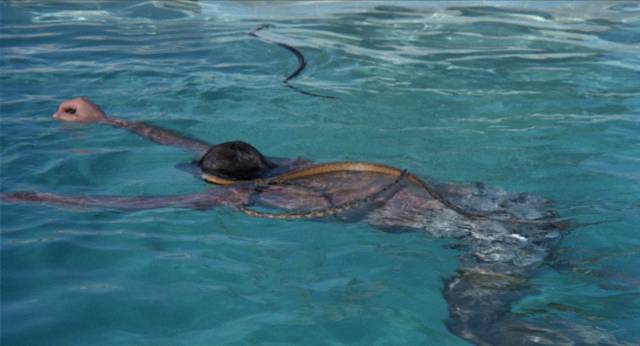
To make matters worse, an acquaintance who runs a seedy bar where Gloria Calvin (Marcia Knight) uses Tim-supplied snakes in her strip act decides to spice things up to bring in more customers – so he has Gloria end her act by actually biting the head off a snake. Between the poaching and the creepy act, Tim’s PTSD kicks in and he sends Stanley and his friends in to kill off all the bad people. Although snakes are inherently creepy, they lack the dramatic on-screen presence of sharks, so Stanley seems like a not entirely successful trial run for Mako, but it does give Grefé an opportunity to spend more time in his beloved Florida swamps.
Vinegar Syndrome’s 2K scan from the original negative is an improvement over BCI’s 2008 DVD special edition and makes a nice supplement to Arrow’s Grefé box set. There’s a commentary from writer Gary Crutcher, a making-of documentary and featurette about the locations, and a post-screening Q&A with cast and crew-members.
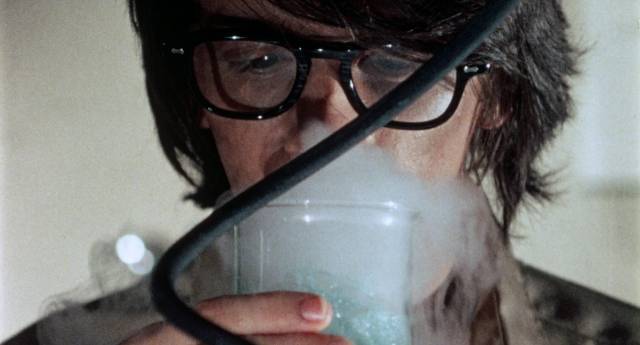
Grefé’s feature is joined in VS’s double-feature two-disk set by Larry N. Stouffer’s Horror High (1973), the second of only two features the Texas filmmaker directed. Previously unknown to me, this is one of those unexpected finds which makes me appreciate companies like Vinegar Syndrome. It fits neatly into my fondness for low-budget regional genre filmmaking – shot in two weeks on a reputed budget of only $67,000, it displays the kind of enthusiasm and invention I look for but don’t always find.
Vernon Potts (Pat Cardi) is a high school science nerd who is always in trouble with his teachers (and, of course, the coach) because he doesn’t care about regular lessons as he puts all his time and effort into the biology lab and his study of his guinea pig, Mr. Mumps. Strangely, Vernon appeals to popular girl Robin Jones (Rosie Holotik), but the attention he gets from her just serves to provoke her football jock boyfriend Roger (Mike McHenry) into ramping up the bullying.
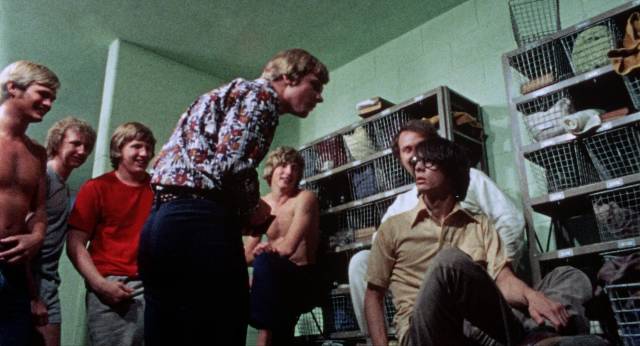
In the lab, Vernon is working on a formula which he gives to Mr. Mumps with the unexpected result of turning the cute rodent into a snarling beast. Under the influence of the drug, Mr. Mumps finally gets revenge on the custodian’s cat which is always trying to break into his cage. Discovering the dead kitty, the custodian (Nick Felix) is incensed and forces Vernon to drink his own formula … and before you can say Jekyll-and-Hyde, Vernon is losing control of his mild-mannered self and getting revenge on his tormentors, bullying jocks and nasty teachers alike.
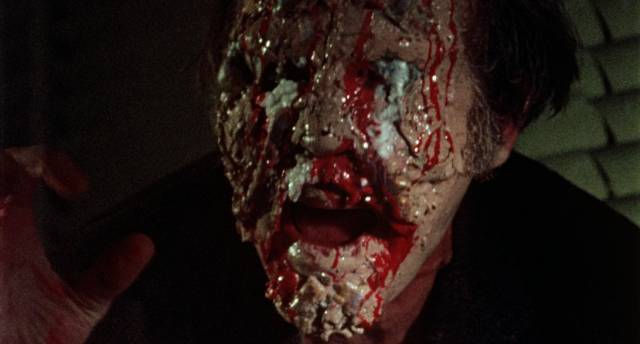
Stouffer handles the narrative with pace and humour and some effective gore, making Horror High a respectable entry in the nerd-turns sub-genre which would really take off three years later with Brian DePalma’s Carrie (1976). Cheap and cheerful, it features a surprise bit of casting with Austin Stoker, star of John Carpenter’s Assault on Precinct 13 (1976), turning up as Lieutenant Bozeman, the cop investigating the series of bizarre deaths, who senses that there’s something odd about Vernon but can’t quite put his finger on what.
Vinegar Syndrome’s 2K scan reveals every grainy detail of this scrappy drive-in product, made from the only known uncut print. Detail and colour are surprisingly good, and there are few signs of wear or print damage. There’s a spotty commentary from star Cardi, plus new and archival interviews with the actor, as well as actors Michelle Falerne and John Niland and writer J.D. Feigelson, who went on to write the made-for-television classic Dark Night of the Scarecrow (1981).
*
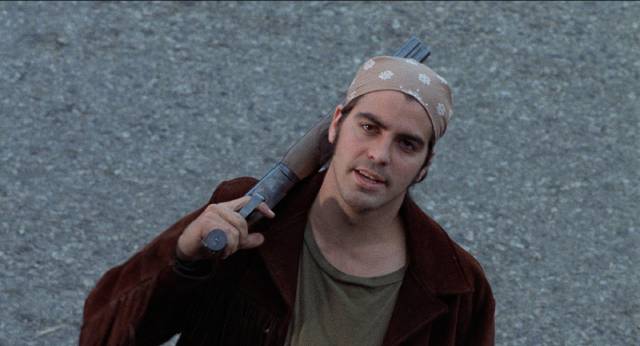
Red Surf (H. Gordon Boos, 1989)
George Clooney was a decade into his career as a television actor, but still five years away from becoming a star on ER (1994-2009), and had previously only appeared in two features – Return to Horror High (1987) and Return of the Killer Tomatoes (1988) – when he got his first starring role on the big screen. Given his subsequent trajectory, it seems odd that H. Gordon Boos’ Red Surf (1989) is all but forgotten; when it was made, Clooney was not yet a household name, but once he did become famous, it would seem reasonable that this would resurface … and yet it’s taken three decades. Although there’s nothing particularly remarkable about Red Surf, it’s certainly not the kind of embarrassment stars sometimes try to suppress.
Boos had a successful career as a second unit and assistant director, beginning with smaller movies and working his way up to projects by Oliver Stone and Francis Ford Coppola, before trying his hand at directing with this feature, which he also co-wrote. Clooney plays Remar, a former surfing star sidelined by an injury, who now survives by dealing drugs with his buddy Attila (Doug Savant) and their irresponsible friend True Blue (Philip McKeon). He lives with girlfriend Rebecca (Dedee Pfeiffer), but is unwilling to grow up – which is why she’s reluctant to tell him that she’s pregnant. In fact, she gets more support from Remar’s loyal pal Attila, than from Remar himself.
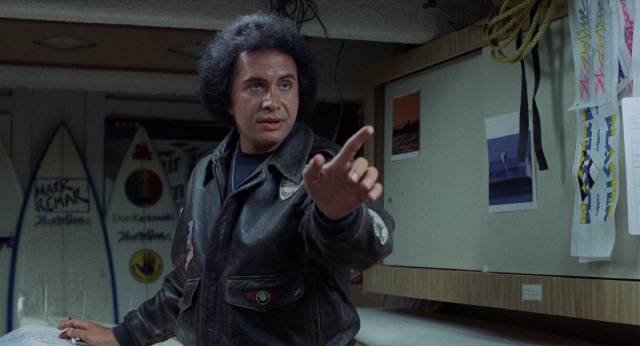
Like many movie slackers before him, Remar keeps promising to get out of the drug business and find a real job – he just needs to make one more big score. And like so many such plans in movie history, things don’t go as intended and Remar and his friends run afoul of the East L.A. kingpin they work for (Rick Najera). As Remar tries to find a way out, things become surprisingly dark, and there are real, bloody consequences for his poorly made decisions.
Clooney works his familiar charm overtime to keep the perpetually self-defeating Remar sympathetic and it’s easy to see why he soon became a star. The rest of the cast provides able support, even Gene Simmons as the friends’ older mentor. John Schwartzman, early in a career which would lead to some of Hollywood’s biggest movies (including several for Michael Bay), shoots it all with a nice feel for sun and surf and the seedy undertones of lives which have become aimless, but in the end it never really rises above familiar tropes.
It does look good, though, in Vinegar Syndrome’s 4K scan from the original negative. The disk includes a producer commentary and several interview featurettes.
*
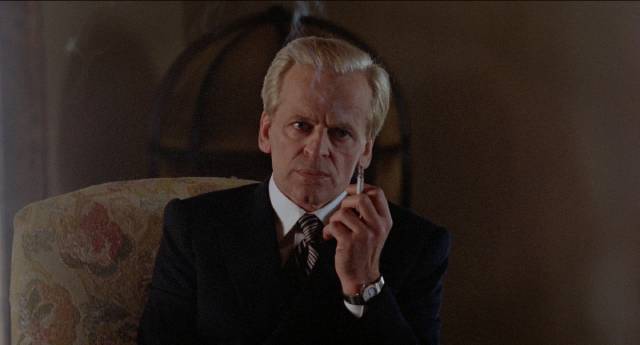
Schizoid (David Paulsen, 1980)
/ X-Ray (Boaz Davidson, 1981)
The three-disk dual-format double bill of David Paulsen’s Schizoid (1980) and Boaz Davidson’s X-Ray (1981), a pair of Cannon Films thrillers, was something of a disappointment. Not that I was expecting unsung masterpieces, of course, but both films are unsatisfying in their own idiosyncratic way. Cannon, best-known for their action movies, here try their hand with the relatively new slasher genre.
Paulsen’s movie actually fits more comfortably into another genre niche – the group-therapy-serial-killer story; think John Huston’s Phobia (1980) and Richard Rush’s Color of Night (1994). Advice columnist Julie (Marianna Hill) is in therapy to deal with issues lingering from her now-ended marriage to her editor Doug (Craig Wasson). Therapy sessions sometimes continue with Julie and her fellow female patients hanging out in a hot tub complaining about men. Someone who seems to know what’s discussed in the sessions is sending threatening letters to Julie (composed with words cut out of newspapers and magazines) … and she eventually goes to the police when other patients start turning up dead. Yes, there’s a gloved killer on the loose, stabbing group members with a pair of scissors.
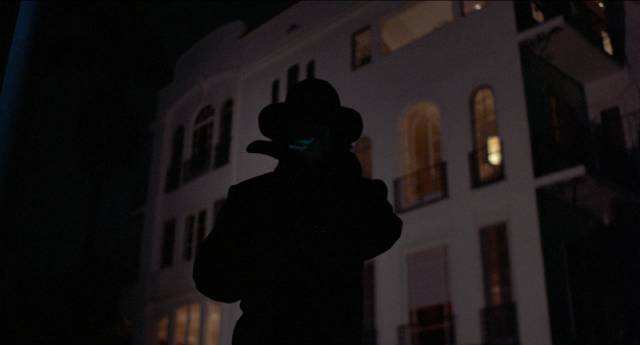
So far, so familiar. What does stand out is the casting of Klaus Kinski as Dr. Pieter Fales, a choice which skews the movie in odd directions, not least because he has a habit of becoming sexually involved with his patients, most recently with Julia herself. I like Kinski, he’s a fascinating actor, but his screen persona is always unsettling and it’s impossible to buy him as romantically appealing. On top of that, Fales has a very disturbing relationship with his teenage daughter Alison (Donna Wilkes), who listens in on the group therapy sessions and gets very jealous of her dad’s lovers. The eventual resolution of the story isn’t too surprising, but the perverse undertones do give the movie a distinctive atmosphere.
Israeli Boaz Davidson began directing in the early ’70s and eventually became involved with Cannon, where he was mentored by Menahem Golan and Yoram Globus, becoming a prolific producer himself for Nu Image (now Millennium Films), which eventually took over Cannon’s market position. As a director, he was best known for his Israeli feature Lemon Popsicle (1978) and the U.S. remake The Last American Virgin (1982). But between those, he tried his hand at slasher horror with X-Ray, a movie so packed with absurdities that it can only be read as a parody of the genre.
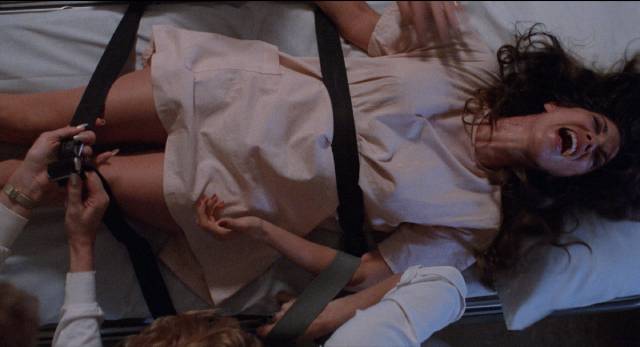
In a prologue, young Susie receives a Valentine’s card from her nerdy neighbour Harold, who overhears her mocking him to her brother. Naturally upset, Harold kills the brother. Years later, Susan (Barbi Benton) is dropped off at a hospital by boyfriend Jack (Jon Van Ness) to get some routine test results from her doctor. Things immediately get weird as someone switches the results so that it looks as if she has a really serious medical condition. She suddenly finds herself forcibly admitted, in effect becoming a prisoner as staff impose intrusive physical examinations on her (Benton, a former Playboy playmate, spends a fair amount of time exposed and manhandled by doctors).
The absurdity of Susan’s inability simply to walk out of the hospital is hard to swallow, as is Jack’s waiting outside in the car for hours when she was supposed to pop in for just a few minutes. Meanwhile, someone is knocking off members of the staff in order to further isolate her – someone who has inexplicable powers to move patients around and completely change rooms in order to make it appear that Susan is losing her grip on reality. When you learn that all this is happening on Valentine’s Day, it’s not hard to figure out who is stalking her – it’s just a matter of identifying which member of the staff is the grown up Harold, not difficult when the helpful intern introduces himself as Harry (Charles Lucia).
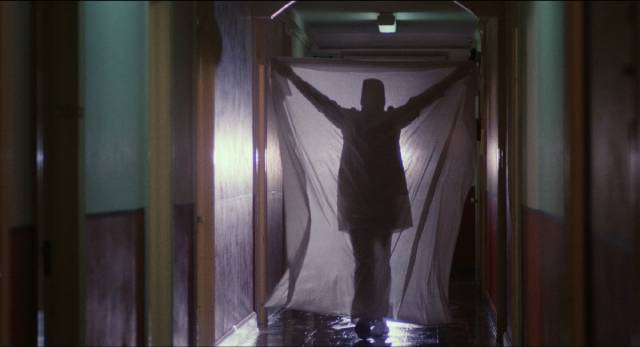
The narrative absurdities of X-Ray make it impossible to enjoy as a straight thriller – Susan’s complete lack of agency is an inexplicable plot contrivance which seems more like the laziest kind of writing, which is surprising coming from someone as experienced as screenwriter Marc Behm, whose credits go all the way back to Harald Reinl’s The Return of Dr. Mabuse (1961), Stanley Donen’s Charade (1963), Guy Hamilton’s The Party’s Over (1965) and Richard Lester’s Help! (also 1965).
Both movies look excellent in Vinegar Syndrome’s 4K scans; they each get a separate UHD disk and are combined on a single Blu-ray with all the extras, which consist of a number of brief cast and crew interviews, plus an X-Ray making-of.
*
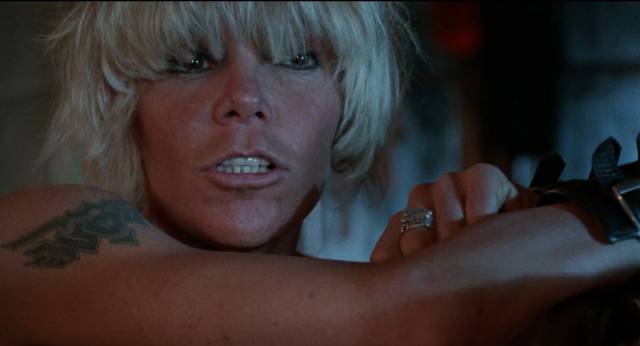
Reform School Girls (Tom DeSimone, 1986)
If X-Ray is an inadvertent parody, Tom DeSimone’s Reform School Girls (1986) knows exactly what it’s doing. DeSimone (who had a pseudonymous career directing gay porn, and in the late ’80s got busy directing episodic television) obviously knows the women-in-prison genre inside and out – all the familiar tropes are here: the naive girl who inadvertently falls afoul of the law and is sentenced to prison, the warden who lacks empathy and is only concerned with the rules, the sadistic guard who exacts sexual favours from the inmates, the inmate cliques which vie for control and prey on the weak… DeSimone doesn’t so much mock these elements as push them just over the line into absurdity while maintaining the integrity of the familiar narrative. He skilfully sustains a tone which is both B-movie sincere and affectionately comedic.
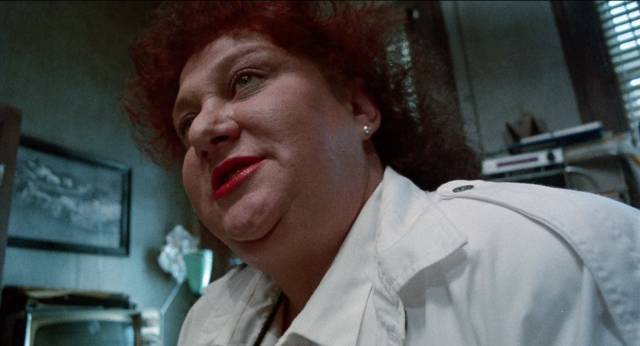
Jenny (Linda Carol) is sent up after her boyfriend botches a robbery and finds herself dealing with Warden Sutter (Sybil Danning), sadistic and sexually predatory guard Edna (Pat Ast), vulnerable fellow newbie Lisa (Sherri Stoner) and, most importantly, alpha inmate Charlie played by an over-the-top Wendy O. Williams, lead singer of The Plasmatics, who injects some real punk energy into the proceedings.
Trashy, offensive and indefensibly entertaining, Reform School Girls was produced by New World Pictures and although it was made a few years after Roger Corman sold the company, it displays all the earmarks of his exploitation savvy. The 2K transfer from a 35mm interpositive is colourful, and there are plenty of extras, including two commentaries – an archival one with DeSimone and a new one with queer film historian Elizabeth Purchell – plus a 54-minute making-of documentary, a pair of short tributes to Pat Ast and Wendy O. Williams and an unwatchable archive video of a women-in-prison stage play starring Ast.
*
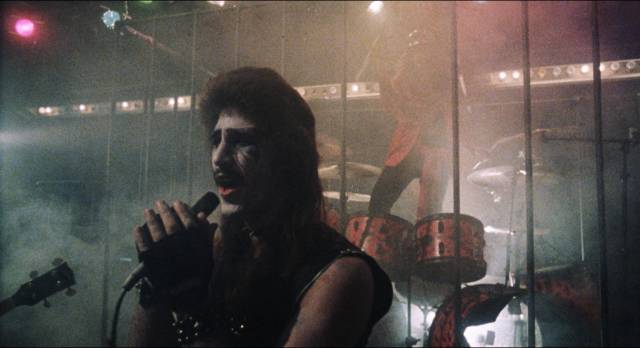
Hard Rock Zombies (Krishna Shah, 1985)
/ Slaughterhouse Rock (Dimitri Logothetis, 1987)
If you’re going to make a musical built around genre cliches, you need to get a couple of things right to make it work – the cliches, and the music. This pair of oddities, one played for comedy, the other for horror, struggle to find that sweet spot.
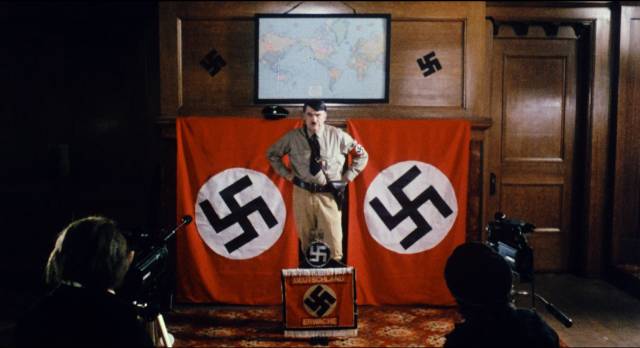
Born in India, writer-director Krishna Shah made a couple of serious American dramas and a Bollywood caper film before co-writing and directing the Cannon release Hard Rock Zombies (1985). It’s an absurd concoction about a band which winds up in a bizarre town which is hostile to rock and are killed by the locals, only to be revived as zombies when a tape of one of their songs is played (the lyrics are actually an ancient incantation). As more people die and return as zombies, the band’s manager is determined to go through with their show because he’s lined up a record company A&R guy in hopes of signing a deal despite the fact the band members are all dead. Meanwhile, it turns out that Hitler is alive and living in the town with wife Eva Braun, who happens to be a werewolf.
Shah’s movie works overtime to attract a cult audience, but falls flat where it really counts. Despite the title, the band actually play sappy soft rock ballads. The music is soporific rather than rousing and fails to redeem all the strained comedy nonsense.
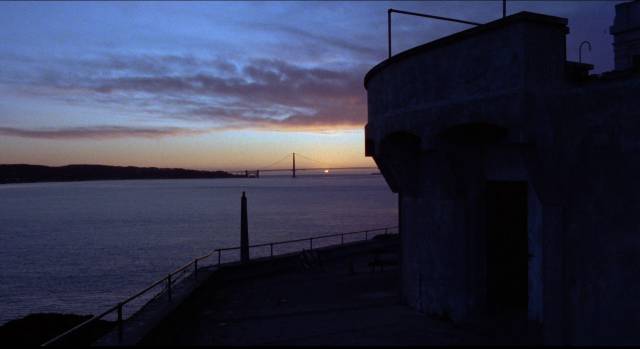
Dimitri Logothetis’ Slaughterhouse Rock (1987) doesn’t make much more sense, but it does benefit from a score by none other than Devo. The music is much better here, though there isn’t enough of it given that we have a demonic band for the characters to deal with. Shortly after a demon kills the band on Alcatraz, college student Alex (Nicholas Celozzi) begins to have nightmares in which he’s attacked by the demon, nightmares which begin to manifest in his waking life. His girlfriend Jan (Tammy Hyler) takes him to talk to Professor Carolyn Harding (Donna Denton), an expert on the supernatural, who deduces that he’s under attack by the prison’s former commander who was put to death for his murderous cannibal crimes.
The Prof and Jan, along with Alex’s brother and roommates, take him to Alcatraz to confront the evil forces at work. As those forces distort reality and isolate the group from each other, Alex is drawn towards what he saw in his nightmares – climaxing with the appearance of the dead band’s lead singer Sammy Mitchell, played by pop star and dancer Toni Basil, who has a show-stopping number that points toward the resolution of Alex’s problems.
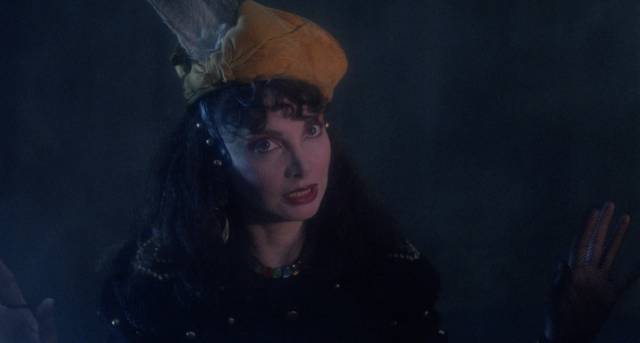
Uneven and half-baked, Slaughterhouse Rock benefits from the Devo score and some location work on Alcatraz, but as with Hard Rock Zombies the elements never really come together into a satisfying whole.
Hard Rock Zombies was scanned in 2K from the only known 35mm elements, with some sections inserted from inferior tape sources, so it looks a bit battered. Slaughterhouse Rock fares better with a 4K scan from the original negative, which is helpful as much of the movie was shot at night and on underlit locations. Each movie gets its own disk, with Hard Rock Zombies having more substantial extras – a 66-minute documentary, a 21-minute featurette on the special effects, an interview with actress Susette Boggs, and an interview author Lucy Hall, who’s a big fan of the movie. Slaughterhouse Rock features interviews with cinematographer Nicholas von Sternberg (son of director Josef von Sternberg), who also shot X-Ray, and actors Nicholas Celozzi, Tammy Hyter and Al Fleming.
*
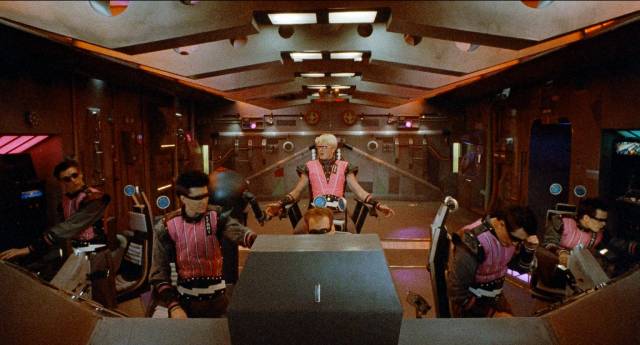
Voyage of the Rock Aliens (James Fargo, 1984)
If Hard Rock Zombies and Slaughterhouse Rock were disappointing, one of the most unexpected pleasures to arrive from Vinegar Syndrome recently – a movie I wouldn’t have ordered and so wouldn’t have seen if not for my subscription – was Voyage of the Rock Aliens (1984). Absurd from beginning to end, it’s buoyantly entertaining thanks to a cast led by Pia Zadora and featuring Ruth Gordon and Michael Berryman (whoever expected to see them together in a movie?) and, most importantly, an endlessly catchy collection of songs by former Christian rock band Rhema.
The band members – Jeffrey Casey, Marc Jackson, Craig Jensen, Patrick Byrnes and Gregory Bond – play a group of aliens scouring the universe in their guitar-shaped spaceship in search of the best rock music. Tuning in to various radio signals, they’re eventually led to an obscure little planet named Earth, where they land in a small town named Speelburgh, which happens to be home to a rockabilly band headed by Frankie (Nightbreed’s Craig Sheffer). Frankie’s girlfriend is perky Dee Dee (Zadora), who wants to head a band of her own, though her domineering boyfriend won’t hear of it.
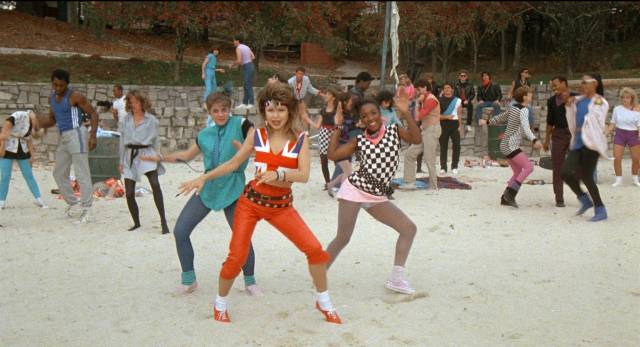
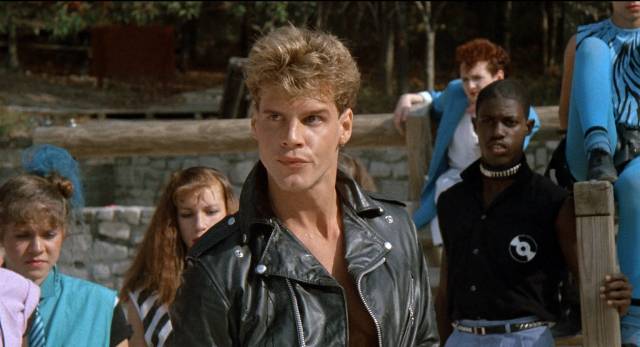
When the aliens land, their leader ABCD (Tom Nolan) is smitten with Dee Dee and decides that he and his crew could be her back-up band, leading to a climactic showdown at a town dance where the aliens have a musical duel with Frankie’s band, alternating verses of “Let’s Dance Tonight” in rock and rockabilly versions. Along the way, there’s Michael Berryman running around town with a chainsaw and Ruth Gordon as the local sheriff with an obsession about aliens, plus a variety of very catchy musical numbers. Who would have expected something like this from director James Fargo, a long-time assistant director who got his directing start courtesy of Clint Eastwood on the Dirty Harry movie The Enforcer (1976) and Every Which Way But Loose (1978).
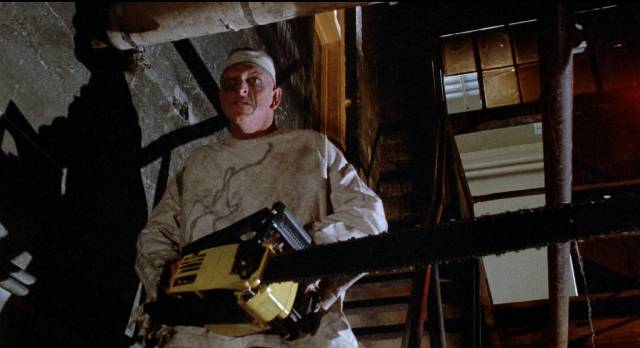
The 2K transfer from a 35mm interpositive is appropriately bright and colourful and the disk includes two excellent long featurettes – one on the production itself, which was troubled, with Zadora’s husband Meshulam Riklis asserting his influence in post-production and eventually pushing Fargo out. It was Riklis who insisted that the movie open with the recently shot video of Zadora’s duet with Jermaine Jackson on “When the Rain begins to Fall”, which has nothing to do with the rest of the movie and suggests that we’re in for something like an early ’80s Italian post-apocalyptic experience rather than what we actually get. (The not-entirely-clear suggestion is that this is just one of the random transmissions intercepted by the aliens before they settle on Earth as their destination.)
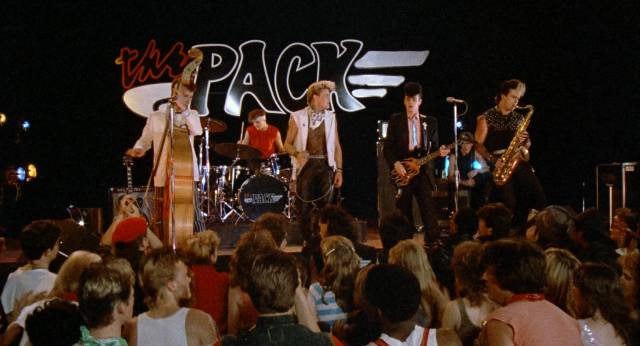
The second featurette brings together the members of Rhema who talk about their origins in Christian rock, about applying to write some music for the film only to end up cast as the aliens despite their having no acting experience – which actually serves them well, their lack of experience giving the aliens an awkward naivety which plays well in context. They look back on the production with humour and provide a lot of interesting details: for instance, some of the band members worked with people with physical and psychological disabilities, one of whom had a strange obsession with someone he called the tractor man – the lyrics of the song “Combine Man” are entirely made up from words and phrases spoken by that man. Like the movie itself, this featurette has an infectious upbeat charm.
Comments